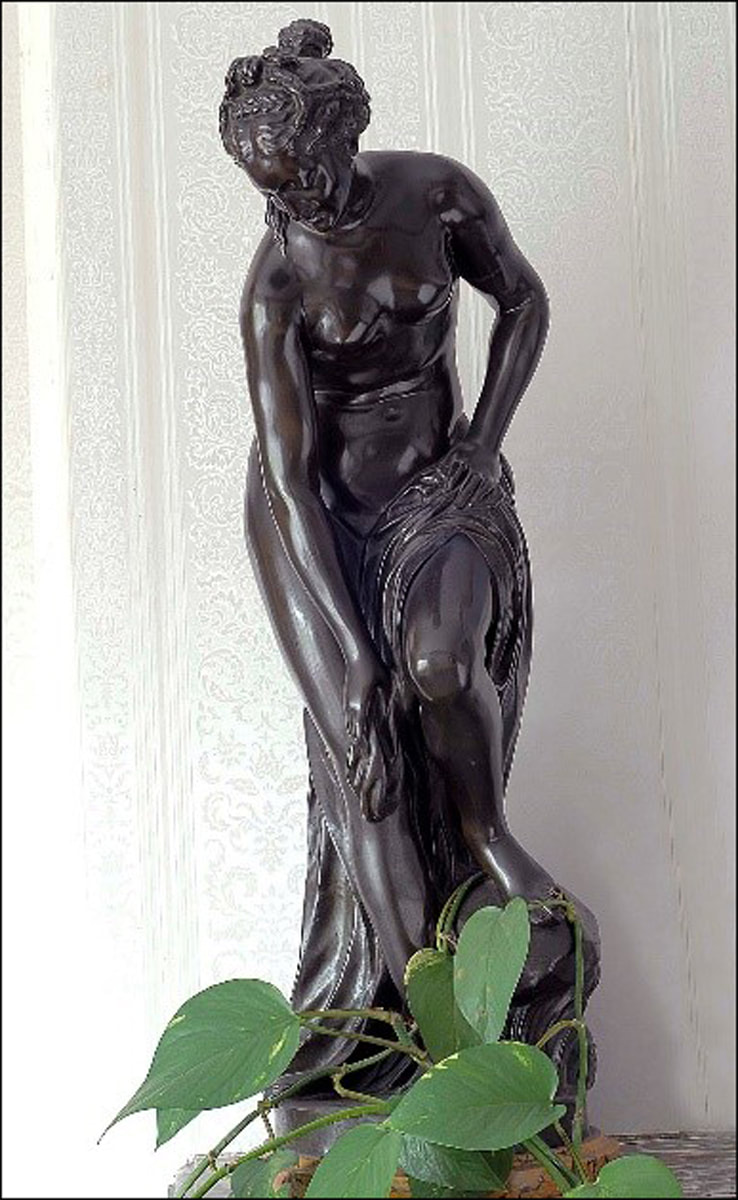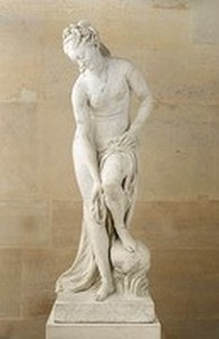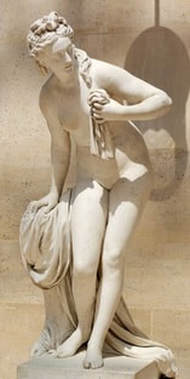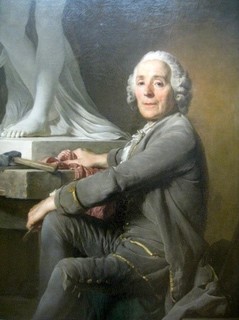Venus (The Bather) Bronze Figurine
|
Research by Jacqueline Arundel and Marjorie Gregson
|
|
Acc No ?
Artist Christophe-Gabriel Allegrain (after) Artist dates 1710-1795 Medium Bronze Size Height 87.6 cm (34.5 in) overall Date produced Late 19th century Inscr: signed 'ALLEGRAIN' to base Donor Mr & Mrs Aaron Harris Garden Street, St Annes on Sea 'in commemoration of the present mayoralty' Date donated 27 January 1947 |
THE ARTIST
This French neo-classical sculptor was born in Paris to a family of artists. His grandfather, Etienne Allegrain (1644-1736), and his father, Gabriel Allegrain (1679-1748), were classical landscape artists. His uncle, Jean-Baptiste Allegrain (c1644-1714), and Christophe-Gabriel’s own son, Gabriel Allegrain (c1733-1779), were both sculptors.
A pupil of Martin, an ornamental sculptor, he owed his advancement to his brother-in-law, Jean Baptiste Pigalle, who generously helped him in the execution of his work. Allegrain’s early career was dominated by this relationship as he collaborated with Pigalle on several monuments. He seems to have been slow to develop and be recognised.
His first appearance at the Salon was in 1747 with a plaster Narcissus, of which the marble became his reception piece at the Academie in 1751. “This piece, once attributed to Pigalle, has a sleepy charm typical of Allegrain at his best.”
Allegrain’s most famous work, Venus at the Bath (also known as The Bather or La Baigneuse), commissioned in 1756 and completed in 1767, was his sole Court commission, apart from the lost Batteuse de buerre, executed in stone for Madame de Pomadour’s dairy at Crecy. Louis XV gave Venus to Madame du Barry, who placed it in the garden of her Chateau de Louveciennes. After the king’s death she commissioned from Allegrain a pendant bather of practically the same subject, Diana surprised by Actaeon, which was also placed in her landscaped garden. Both are now in the Louvre: the pieces remain popular and are often reproduced - "As Venus and Diane they provided an allegory of Du Barry’s past sensual love and her present chaste condition".
REFERENCES
www.augustastylianougallery.com
www.wga.hu
www.tuttartpitturascuturapoesiamusica.com
Levey, Michael, "Painting and Sculpture in France 1700-1789”
Beaulieau, Michele, (1955), Une etude de Allegrain pour la Venus au bain, BSHAF, pp59-62
Diderot, Denis, (1995), Ruines et paysage, Salon de 1767, Paris, Editions Hermann, pp483-5
Louvre, (2015), Diderot et l'art de Boucher cat. exp. Paris, Hotel de la Monnaie, 1984-1985, Paris, 1984, pp436-439,
available online http://www.louvre.fr/en/oeuvre-notices/bather-also-called-venus
This French neo-classical sculptor was born in Paris to a family of artists. His grandfather, Etienne Allegrain (1644-1736), and his father, Gabriel Allegrain (1679-1748), were classical landscape artists. His uncle, Jean-Baptiste Allegrain (c1644-1714), and Christophe-Gabriel’s own son, Gabriel Allegrain (c1733-1779), were both sculptors.
A pupil of Martin, an ornamental sculptor, he owed his advancement to his brother-in-law, Jean Baptiste Pigalle, who generously helped him in the execution of his work. Allegrain’s early career was dominated by this relationship as he collaborated with Pigalle on several monuments. He seems to have been slow to develop and be recognised.
His first appearance at the Salon was in 1747 with a plaster Narcissus, of which the marble became his reception piece at the Academie in 1751. “This piece, once attributed to Pigalle, has a sleepy charm typical of Allegrain at his best.”
Allegrain’s most famous work, Venus at the Bath (also known as The Bather or La Baigneuse), commissioned in 1756 and completed in 1767, was his sole Court commission, apart from the lost Batteuse de buerre, executed in stone for Madame de Pomadour’s dairy at Crecy. Louis XV gave Venus to Madame du Barry, who placed it in the garden of her Chateau de Louveciennes. After the king’s death she commissioned from Allegrain a pendant bather of practically the same subject, Diana surprised by Actaeon, which was also placed in her landscaped garden. Both are now in the Louvre: the pieces remain popular and are often reproduced - "As Venus and Diane they provided an allegory of Du Barry’s past sensual love and her present chaste condition".
REFERENCES
www.augustastylianougallery.com
www.wga.hu
www.tuttartpitturascuturapoesiamusica.com
Levey, Michael, "Painting and Sculpture in France 1700-1789”
Beaulieau, Michele, (1955), Une etude de Allegrain pour la Venus au bain, BSHAF, pp59-62
Diderot, Denis, (1995), Ruines et paysage, Salon de 1767, Paris, Editions Hermann, pp483-5
Louvre, (2015), Diderot et l'art de Boucher cat. exp. Paris, Hotel de la Monnaie, 1984-1985, Paris, 1984, pp436-439,
available online http://www.louvre.fr/en/oeuvre-notices/bather-also-called-venus




